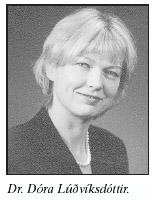Fræðigreinar
Nýr doktor í læknisfræði
Þann 17. september síðastliðinn lauk Dóra Lúðvíksdóttir doktorsprófi í læknisfræði frá Uppsalaháskóla. Doktorsritgerðin ber titilinn Airway Responsiveness and Exhaled Nitric Oxide. Studies in asthma and Sjögren´s syndrome. Ritgerðin fjallar um loftvegabólgu og berkjuauðreitni hjá sjúklingum með astma og einstaklingum með heilkenni Sjögrens. Rannsökuð voru tengsl berkjuauðreitni og köfnunarefnisoxíðs (NO) í útöndunarlofti við loftvegaeinkenni og bólguþætti í blóði. Ágrip af ritgerðinni fer hér á eftir.
In this thesis, four different types of provocation agents: methacholine, adenosine 5´-monophosphate (AMP), cold air and dry powder mannitol were used to study different aspects of the airway responsiveness profile in asthma and Sjögren´s syndrome. Exhaled nitric oxide (NO) and markers of eosinophil activation, serum eosinophil peroxidase (S-EPO) and serum eosinophil cationic protein (S-ECP) were measured.
The main findings of this research are that atopic patients with asthma were significantly more hyperresponsive to AMP than nonatopic asthmatic subjects and patients with Sjögren´s syndrome. In atopic subjects with asthma, the airway responsiveness to AMP was correlated with markers of eosinophil activation S-EPO and S-ECP. Furthermore, hyperresponsiveness to cold air was more common in atopic asthmatics compared with patients with Sjögren´s syndrome.
Exhaled NO was almost twice as high in patients with Sjögren´s syndrome and atopic asthmatics compared with healthy controls. In atopic asthmatics exhaled NO was significantly correlated with airway responsiveness to methacholine and was due to an increased NO flux from the airways but not the alveoli. After inhalation of dry powder mannitol the levels of exhaled NO decreased in asthmatics, but increased in healthy individuals.
In conclusion, atopic and nonatopic subjects with asthma and patients with Sjögren´s syndrome have different airway responsiveness profiles for AMP and cold air. Exhaled NO is elevated in patients with Sjögren´s syndrome and in atopic asthmatic subjects while nonatopic asthmatics have normal levels. Using a new bronchial provocation test with dry powder mannitol we showed that healthy subjects can release NO after mannitol provocation, wheras asthmatics can not. More than one type of bronchial provocation may be required to detect different aspects of the airway hyperresponsiveness profile.
Dóra starfar sem sérfræðingur við lungnalækningaskor lyflækningasviðs Landspítala Vífilsstöðum.
In this thesis, four different types of provocation agents: methacholine, adenosine 5´-monophosphate (AMP), cold air and dry powder mannitol were used to study different aspects of the airway responsiveness profile in asthma and Sjögren´s syndrome. Exhaled nitric oxide (NO) and markers of eosinophil activation, serum eosinophil peroxidase (S-EPO) and serum eosinophil cationic protein (S-ECP) were measured.
The main findings of this research are that atopic patients with asthma were significantly more hyperresponsive to AMP than nonatopic asthmatic subjects and patients with Sjögren´s syndrome. In atopic subjects with asthma, the airway responsiveness to AMP was correlated with markers of eosinophil activation S-EPO and S-ECP. Furthermore, hyperresponsiveness to cold air was more common in atopic asthmatics compared with patients with Sjögren´s syndrome.
Exhaled NO was almost twice as high in patients with Sjögren´s syndrome and atopic asthmatics compared with healthy controls. In atopic asthmatics exhaled NO was significantly correlated with airway responsiveness to methacholine and was due to an increased NO flux from the airways but not the alveoli. After inhalation of dry powder mannitol the levels of exhaled NO decreased in asthmatics, but increased in healthy individuals.
In conclusion, atopic and nonatopic subjects with asthma and patients with Sjögren´s syndrome have different airway responsiveness profiles for AMP and cold air. Exhaled NO is elevated in patients with Sjögren´s syndrome and in atopic asthmatic subjects while nonatopic asthmatics have normal levels. Using a new bronchial provocation test with dry powder mannitol we showed that healthy subjects can release NO after mannitol provocation, wheras asthmatics can not. More than one type of bronchial provocation may be required to detect different aspects of the airway hyperresponsiveness profile.
Dóra starfar sem sérfræðingur við lungnalækningaskor lyflækningasviðs Landspítala Vífilsstöðum.

